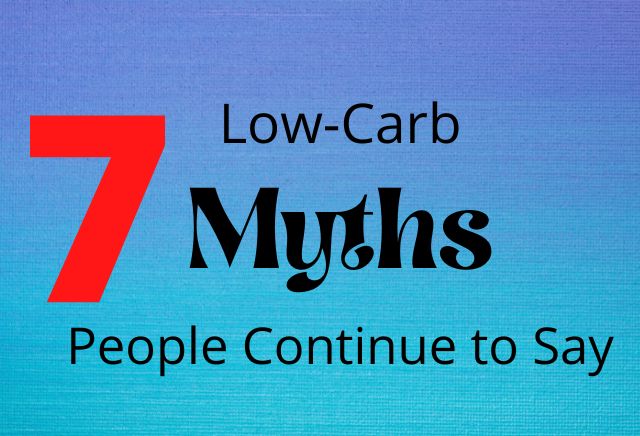
7 Low-Carb Myths People Continue to Say
If you’ve done any type of research online for information on low-carb diets, it’s not hard to find tons of conflicting information. In fact, there’s so much misinformation on the Internet that it makes it difficult for people to really learn what’s true and what’s not.
Sadly, I’ve noticed many people who repeat these low-carb myths often don’t have an understanding of what low-carb eating really is or just how beneficial it can be for someone.
On top of that, while there are a large number of doctors, dietitians, and nutritionists who wholeheartedly advocate for low-carb lifestyles, unfortunately, the standard nutrition classes still persist with teaching the same old information.
This is part of the reason I wanted to create this blog in the first place. And chances are you’ve seen other blog posts similar to this one. So why add another of the same? Because the more we can get this information out there, the more we can hopefully spread awareness and help others make healthier changes in their lives.
We’re going to take a look at seven different low-carb myths that continue to be repeated despite plenty of information to the contrary.
Low-Carb Myth #1: It’s Unsustainable
This just simply isn’t true.
For one, there are individuals who have been eating low-carb for decades, and if it was completely unsustainable, they would not have been able to maintain this eating style without running into health problems or simply giving up.
Typically, they report being in better health since switching to low-carb eating compared to their prior high-carb diets.
I, personally, follow a number of doctors and nutritionists on social media who have been eating this way for years, if not decades, themselves while also helping their patients do the same.
But anecdotes aside, many scientific trials have also shown that low-carb diets are no more difficult to stick to than the typically recommended calorie-restricted or low-fat diets.
This interesting article on healthline.com looked at 19 different randomized controlled trials comparing low-carb diets to low-fat diets, and found the participants in each group were able to stick to their assigned way of eating with roughly the same degree of success.
In fact, the amount of people successfully sticking to the low-carb diets was slightly higher than their low-fat counterparts.
Here’s the reality behind this myth: changing your eating habits is a big lifestyle change, and it takes a good amount of dedication and effort to make it stick.
It’s easier for people to label a low-carb diet as unsustainable than it is to acknowledge the level of personal accountability we have in whether or not we succeed at any lifestyle change, including changing our eating habits.
And I have 100% been one of those people until I took a long hard look at myself and realized I couldn’t blame the diet for my lack of effort.
I realize that changing habits can be hard, so here are a couple of other blog posts that can help:
- 7 Awesome Benefits of Meal Planning & Prepping
- How Long it Really Takes to Create a New Habit & 8 Steps to Help You Be Successful
Low-Carb Myth #2: It’s a Fad Diet
This is a common one you’ll see a lot. Eating styles that don’t adhere to the standard nutrition information we’ve been led to follow most of our lives are often labeled as a fad.
Labeling low-carb or Keto as a “fad” is also an easy way for people to be dismissive of it without having to educate themselves. And yes, there are many fad diets out there, but low-carb is not one of them. It’s actually been around longer than you may realize.
The first official account of a written document concerning low-carb eating was published by William Banting in 1863 called a Letter on Corpulence.
He wrote this after being recommended a lower carb way of eating by his physician to aid in his health issues, and he saw wonderful results that he wanted to share with the rest of the world.
Since then, there have been numerous variations of low-carb diets throughout the years.
The first variation of the Atkins diet was first published in 1972, a full eight years before the first USDA dietary guidelines for Americans was published.
Other examples include The Inuit Diet promoted by Vihjalmur Stefansson (1927), The Alkaline Diet (1935), Eat Fat & Grow Slim by Richard Mackarness (1958), The Stone Age Diet by Walter Voegtlin (1975), Paleolithic Nutrition, a paper published by Stanley Boyd Eaton & Melvin Konner supporting the Stone Age diet (1985) among many, many other variations and papers supporting low-carb.
As you can see, several different variations of low-carb have been around for decades. Unfortunately, we have been fed this low-fat, high-carb way of eating for so long that people think low-carb is simply a fad diet. When in fact, it is not.
Low-Carb Myth #3: It’s All Butter and Bacon
I mean, come on, who doesn’t love butter and bacon?! In all seriousness though, while butter and bacon are often included in low-carb diets, they generally don’t make up the majority of people’s meals.
Of course, there are always exceptions. However, I find it incredibly amusing when people paint a picture of low-carb high-fat eating to be someone just gnawing away on a pound of butter and a plate piled with bacon.
I’m not kidding; I’ve actually seen infographics that portray it as such which sadly just shows a lack of understanding about this way of eating. It unfortunately also promotes misinformation.
In reality, a healthy low-carb diet is abundant in a wide variety of non-starchy vegetables, leafy greens, meats and fish, nuts, healthy fats, and even some fruits such as berries and avocado.
And sure, a little butter and bacon mixed in is just fine.
Low-carb Myth #4: It’s Too Restrictive
Every single eating style restricts something. Read that again.
People who choose to go vegan or vegetarian cut out or restrict meats and animal products. People who eat low fat diets are restricting their fat intake and cut out foods that are higher in fat content.
People who follow a low-calorie eating style are restricting their calories. People who go dairy-free cut out all dairy products. People that tend to eat a free-for-all diet or the Standard American Diet are often restricting their intake of healthy whole foods because these diets are typically high in over-processed nutrient-poor food choices.
Are we seeing a pattern here yet?
If you really stop and think about it, every single eating style excludes or minimizes intake of something. Whether it’s calories, fat, carbs, types of foods such as bread, pasta, meats, dairy, etc. They all have their own variation of restrictions.
Yes, people who choose a low-carb eating style are cutting back on their carbohydrate intake and often limit higher carb foods, but they still get some carbs from non-starchy veggies and sometimes fruits each day. What they are really doing though, is simply choosing to switch the primary fuel their bodies run on from carbohydrates to fats.
Low Myth #5: Eating Low-Carb is Expensive
Honestly, it’s only as expensive as you make it out to be. Look, if you already buy meats, veggies, eggs, cheese, etc. at your local store then you’re already buying exactly what you would need to eat low-carb.
While I fully believe in purchasing animal products that are pasture-raised and grass-fed, I realize this can be outside of the budget for many people. You don’t have to purchase expensive food items to eat a low-carb diet.
What you’d want to cut out is some of the higher carb foods such as breads, pasta, rice, chips, crackers, and high carb vegetables. If you absolutely need to include these for some reason, then you can always lower your carb intake by cutting your normal serving size of those items in half and substituting with extra vegetables.
Your meals don’t have to be anything fancy or overly intricate. They don’t have to include the high-priced low-carb alternative versions of common food items you’ve probably seen advertised. Stick to what works for your budget.
Low-carb Myth #6: Your Brain Can Only Function on Carbs
You’ve probably heard that carbohydrates – or more specifically, glucose – are the preferred fuel source for the brain and that it cannot run on ketones. While there’s a hint of truth to this, it’s not as extreme as it’s been made out to be.
There are some cells in your brain that have to function off of carbs as fuel, but most of your brain can function just fine off of ketones – the energy molecule that comes from fat.
You see, when you don’t eat a lot of carbs in your diet, your body can manufacture the glucose that it needs from proteins, and even a small amount from the by-products leftover from fat metabolism, through a process called gluconeogenesis. So, it can easily keep those cells that need glucose running smoothly while the rest of the brain uses ketones.
Low-carb Myth #7: Ketosis is Dangerous
When I first started in my nutrition degree program, I used to think that ketosis was dangerous; I’ve even said that to people in the past, until I learned better.
Much of this concern came from the very misleading way that ketosis was presented in the nutrition textbooks used in the program. For example, we had a book that lumped nutritional ketosis into the same category as diabetic ketoacidosis but didn’t draw a clear distinction between the two.
And these two metabolic states are in no way the same condition. Nutritional ketosis is a healthy metabolic state for the body to be in while diabetic ketoacidosis can be very serious and even fatal.
Ketoacidosis is basically a very extreme level of ketosis in the body that typically only type 1 diabetics would have to be concerned over and that’s usually if they aren’t managing their condition well.
Ketosis, on the other hand, simply results from the reduction of carbs and increase of fats in the diet. This causes a shift in the primary fuel source the body uses from glucose to ketones.
Typically, people who eat a low-carb or Ketogenic diet will not reach levels of ketones high enough to ever be a concern. But as I said, many nutrition programs do not distinguish between the two, and the result is that medical professionals are taught that being in a state of ketosis is dangerous. It’s not.
Conclusion
Despite plenty of scientific evidence of the years, these myths continue to be spread. And in my opinion, it’s really sad that people may be turned off or away from trying a low-carb way of eating simply because of continued misinformation.
Take the time to check out the information that is available. Research papers, clinical trials, studies, etc. are all available to anyone who takes the opportunity to search for them.
If reading industry jargon isn’t your thing, the abundance of access on the internet and social media sites, make easy to find many nutrition and health professionals who can also help provide information in easy-to-understand language.
Don’t be afraid to challenge old ways of thinking.




